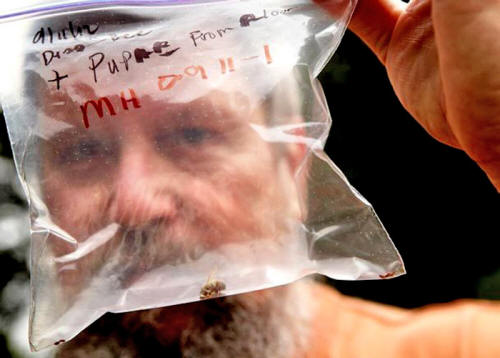|
by Sandi Doughton from SeattleTimes Website
Mark Hohn didn't pay much attention to the dead bees scattered outside his shop when he got home from vacation a few weeks ago. He just pulled out a leaf blower and blasted away the mess.
It took him a few days to realize he had an invasion of the living dead on his hands.
Mark Hohn, a novice beekeeper in Kent, holds up a plastic bag with a dead zombie bee and pupae - two at each end of the bag.
The dead and dying honeybees from Hohn's 1.25-acre spread in Kent are the first in Washington confirmed to be infected by a parasitic fly that causes the bees to lurch around erratically before dropping dead.
The discovery expands the range of the so-called "zombie bees" first discovered in California in 2008 by San Francisco State University biologist John Hafernik.
Through his website ZombeeWatch.org, Hafernik is recruiting a network of citizen scientists, like Hohn, to help determine how widespread the parasite is and whether it is contributing to the demise of bee colonies across the country.
Unlike healthy bees, which spend the night tucked up in their hive, infected bees fly after dark and tend to congregate at lights. Hohn noticed bees buzzing around the light in his shop, flying in jerky patterns and finally flopping on the floor.
He remembered hearing about the zombie bees, so he collected several of the corpses and popped them into a Ziploc bag.
The fly's life cycle is gruesomely reminiscent of the movie "Alien" - though they don't pose a risk to people. Adult females, smaller than a fruit fly, land on the backs of foraging honeybees and use their needle-sharp ovipositors to inject eggs into the bee's abdomen.
The eggs hatch into maggots.
After consuming their host, the maggots pupate, forming a hard outer shell that looks like a fat, brown grain of rice.
When Hohn looked in his Ziploc bag a week later, he saw several pupae - the smoking gun evidence that his bees were infected. He's still waiting for the first adult flies to emerge from the shells, a process that takes three to four weeks.
It's hard to know what effect the parasite is having on his hives, Hohn said.
In a twist on the typical horror-movie plot, it's the parasite that's native to North America, not the bees.
Honeybees were imported by European settlers. The flies, called Apocephalus borealis or scuttle flies, are common coast to coast. But until Hafernik picked up dying honeybees outside his San Francisco laboratory four years ago, the flies had never been known to infect anything but bumblebees and certain types of wasps.
Since then, he and his army of observers have found infected bees throughout western California and Oregon - and now in at least one spot in Western Washington. Nearly 80 percent of hives in the San Francisco Bay Area are infected.
There's also one report from South Dakota.
Bee populations have plummeted in recent years, threatening crops that rely on the insects for pollination. Scientists attribute the decline to a mysterious ailment called Colony Collapse Disorder.
No one knows the exact cause, but researchers have found a variety of mites and viruses that afflict colonies.
Pesticides probably play a role, too, said Steve Sheppard, chairman of the entomology department at Washington State University. His research has shown how the chemicals accumulate in developing bee larvae, shortening the insects' lives.
Sheppard has some of Hohn's zombie bees in his lab for further study.
There's no evidence yet that the parasitic fly is a major player in the bees' decline, but it does seem that the pest is targeting new hosts, Sheppard said.
That's what ZombeeWatch hopes to find out.
The site offers simple instructions for collecting suspect bees, watching for signs of parasites and reporting the results.
Once more people start looking here, the number of sightings will probably climb, Hohn said.
|

